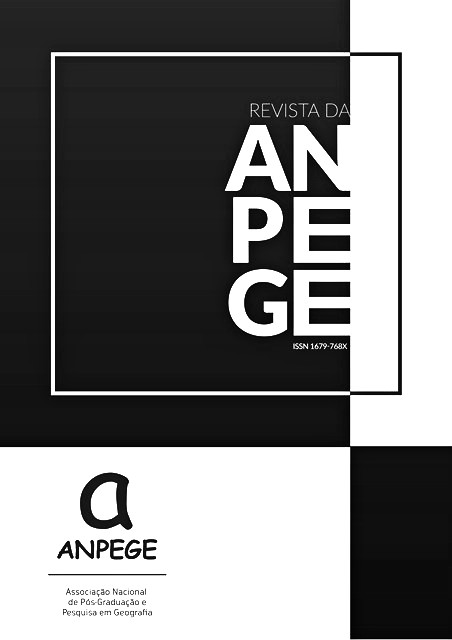Evocativos experienciais dos vínculos de lugar: Ensaio acerca da Geograficidade de ser-no-mundo
DOI :
https://doi.org/10.5418/RA2018.1424.0004Mots-clés :
Experiência geográfica. Sujeito-lugar. Habitar. Intersubjetividade. Corporeidade.Résumé
Na condição de espaços dotados de definição e significado, os lugares são expressões da geograficidade humana. Arquitetados por meio da inseparabilidade do sujeito e sua realidade geográfica, os vínculos de lugar abarcam a dinamogenia relacional de ser-no-mundo. Visa-se, logo, desvelar como as teorias acerca dos vínculos e da corporeidade podem potencializar os estudos do conceito de lugar na Geografia Cultural e Humanista contemporânea. Para tanto, buscou-se realizar um processo de imersão e interpretação bibliográfico concernente ao campo teórico da fenomenologia, particularmente na abordagem existencialista de Merleau-Ponty. Por meio desse fio condutor, compreende-se que o horizonte da realidade geográfica centrado no habitar a Terra indica as tramas de significação do ser. É decifrado que o devir sujeito-lugar está conectado ontologicamente à presentificação e corporificação dos vínculos de lugar em suas amplitudes existenciais. Essa trama experiencial de temporalidade nucleada no instante deve, portanto, ser entendida como um todo dinâmico em que os lugares e sujeitos se metamorfoseiam em reciprocidade contínua.
Téléchargements
Références
ADAMS, P. C.; HOELSCHER, S.; TILL, K. E. Place in Context: Rethinking humanist geographies. In: ADAMS, P. C.; HOELSCHER, S.; TILL, K. E. (Orgs.) Textures of place: exploring humanist geographies. Minneapolis: University of Minnesota Press, 2001, p.xiii-xxxiii.
ALMEIDA, M. G. A propósito do Trato do Invisível, do Intangível e do discurso na Geografia Cultural. Revista da ANPEGE, v. 9, n. 11, p. 41-50, 2013. DOI: https://doi.org/10.5418/RA2013.0911.0004
BACHELARD, G. A intuição do instante. Campinas: Verus Editora, 2010.
BARTOLONI, P. The space of language and the place of literature. In: RICHARDSON, B. (Org.) Spatiality and symbolic expression: on the links between Place and Culture. New York: Paulgrave macmillian, 2015, p.129-153. DOI: https://doi.org/10.1057/9781137488510_7
BROWN, B. B.; PERKINS, D. D. Disruptions in place attachment. In: ALTMAN, I.; LOW, S. M. (Orgs.) Place Attachment. New York: Plenum Press, 1992, p.279-304. DOI: https://doi.org/10.1007/978-1-4684-8753-4_13
CARR, D. Time zones: phenomenological reflections on cultural time. In: CARR, D.; CHAN-FAI, C. (Orgs.) Contributions to phenomenology: Space, Time and Culture. Amsterdan: Springer science+business, 2004, p.3-14. DOI: https://doi.org/10.1007/978-1-4020-2824-3_2
CASEY, E. S. The Fate of place: a philosophical history. Berkley: University of California Press, 1998.
CASEY, E. S. Body, Self and Landscape: A geophilosophical inquiry into the Place-World. In: ADAMS, P. C.; HOELSCHER, S.; TILL, K. E. (Orgs.) Textures of place: exploring humanist geographies. Minneapolis: University of Minnesota Press, 2001, p.403-425.
DARDEL, E. O Homem e a Terra. São Paulo: Perspectiva, 2011.
DEPRAZ, N. Empathy and compassion as experiential praxis: confronting phenomenological analysis and Buddhist teachings. In: CARR, D.; CHAN-FAI, C. (Orgs.) Contributions to phenomenology: Space, Time and Culture. Amsterdan: Springer science+business, 2004, p.189-200. DOI: https://doi.org/10.1007/978-1-4020-2824-3_13
EXPLOSIONS IN THE SKY. The Earth is not a Cold Dead Place. Direção artística: John Congleton. New York: Temporary Residence Label, 2003. 1 Disco sonoro (45 minutos), estéreo.
FULLIOVE, M. T. “The frayed knot”: what happens to place attachment in the context of serial forced displacement? In: MANZO, L. C. (Org.); DEVINE-WRIGHT, P. (Org.) Place Attachment: advances in theory, methods and applications. Abingdon: Routledge, 2014, pp. 141-153.
HOLZER, W. Mundo e lugar: ensaio de geografia fenomenológica. In: MARANDOLA JR., E; HOLZER, W.; LÍVIA, O. (Orgs.) Qual o espaço do lugar? São Paulo: Perspectiva, 2014.
HUFFORD, M. Thresholds to an Alternate Realm: mapping the chaseworld in New Jersey’s Pine Barrens. In: ALTMAN, I.; LOW, S. M. (Orgs.) Place Attachment. New York: Plenum Press, 1992, p.231-252. DOI: https://doi.org/10.1007/978-1-4684-8753-4_11
HUMMON, D. M. Community Attachment: local sentiment and the sense of place. In: ALTMAN, I.; LOW, S. M. (Orgs.) Place Attachment. New York: Plenum Press, 1992, p.253-278. DOI: https://doi.org/10.1007/978-1-4684-8753-4_12
KARJALAINEN, P. T. Place in Urwind: A humanist geography view. Geograficidade. v. 2, n. 2, Inverno 2012. p.4-22. DOI: https://doi.org/10.22409/geograficidade2012.22.a12853
LANG, R. The dwelling door: towards a phenomenology of transition. In: SEAMON, D.; MUGERAUER, R. (Orgs.) Dwelling, place and environment: towards a phenomenology of person and world. Dordrecht: Martinus Nijhoff Publishers, 1985, p.201-214. DOI: https://doi.org/10.1007/978-94-010-9251-7_12
LARSEN, S. C.; JOHNSON, J. T. Toward an open sense of place: Phenomenology, affinity, and the question of being. Annals of the Association of American Geographers, v.102, n.3, p.632-646, 2012. DOI: https://doi.org/10.1080/00045608.2011.600196
LAU, K. Intersubjectivity and Phenomenology of the other: Merleau-Ponty’s contribution. In : CARR, D.; CHAN-FAI, C. (Orgs.) Contributions to phenomenology: Space, Time and Culture. Amsterdan: Springer science+business, 2004, p.3-14. DOI: https://doi.org/10.1007/978-1-4020-2824-3_10
LEWICKA, M. In search of roots: memory as enabler of place attachment. In: MANZO, L. C. (Org.); DEVINE-WRIGHT, P. (Org.) Place Attachment: advances in theory, methods and applications. Abingdon: Routledge, 2014, pp.49-60.
LOW, S. M.; ALTMAN, I. Place attachment: a conceptual inquiry. In: ALTMAN, I.; LOW, S. M. (Orgs.) Place Attachment. New York: Plenum Press, 1992, p.1-12. DOI: https://doi.org/10.1007/978-1-4684-8753-4_1
MARANDOLA JR, E. Tempo e espaço cotidiano – Crônicas de um tecido inacabado. IN: MARANDOLA JR, E.; GRATÃO, L. H. B. Geografia e Literatura: ensaios sobre geograficidade, poética e imaginação. Londrina: EDUEL, 2010, pp.329-347.
MARANDOLA JR, E. Lugar enquanto circunstancialidade. In: MARANDOLA JR., E; HOLZER, W.; LÍVIA, O. (Orgs.) Qual o espaço do lugar? São Paulo: Perspectiva, 2014, p.227-247.
MARCUS, C. C. Environmental memories. In: ALTMAN, I.; LOW, S. M. (Orgs.) Place Attachment. New York: Plenum Press, 1992, p.87-112. DOI: https://doi.org/10.1007/978-1-4684-8753-4_5
MERLEAU-PONTY, M. Fenomenologia da percepção. São Paulo: Martins Fontes, 2011.
MERLEAU-PONTY, M. O visível e o invisível. São Paulo: Perspectiva, 2014.
MERLEAU-PONTY, M. O primado da percepção e suas consequências filosóficas. Belo Horizonte: Autêntica, 2015.
MIHAYLOV, N.; PERKINS, D. D. Community place attachment and its role in social capital development. In: MANZO, L. C. (Org.); DEVINE-WRIGHT, P. (Org.) Place Attachment: advances in theory, methods and applications. Abingdon: Routledge, 2014, pp. 61-74.
MORRIS, D. The sense of space. Albany: State University of New York Press, 2004.
OLIVEIRA, L. O sentido de lugar. In: MARANDOLA JR., E; HOLZER, W.; LÍVIA, O. (Orgs.) Qual o espaço do lugar? São Paulo: Perspectiva, 2014, p.3-16.
RELPH, E. Place and placelessness. London : Pion Limited, 1976.
RELPH, E. Geographical experiences and being-in-the-world: the phenomenological origins of geography. In: SEAMON, D.; MUGERAUER, R. (Orgs.) Dwelling, place and environment: towards a phenomenology of person and world. Dordrecht: MartinusNijhoff Publishers, 1985, p.15-32. DOI: https://doi.org/10.1007/978-94-010-9251-7_2
RICHARDSON, B. The “spatio-cultural dimension”: overview and a proposed framework. In: RICHARDSON, B. (Org.) Spatiality and symbolic expression: on the links between Place and Culture. New York: Paulgrave macmillian, 2015, p.1-20. DOI: https://doi.org/10.1057/9781137488510_1
RISBETH, C. Articulating transnational attachments through on-site narratives. In: MANZO, L. C. (Org.); DEVINE-WRIGHT, P. (Org.) Place Attachment: advances in theory, methods and applications. Abingdon: Routledge, 2014, pp. 100-111.
RUBINSTEIN, R. L.; PARMELEE, P. A. Attachment to place and the representation of the life course by the elderly. In: ALTMAN, I.; LOW, S. M. (Orgs.) Place Attachment. New York: Plenum Press, 1992, p.139-164. DOI: https://doi.org/10.1007/978-1-4684-8753-4_7
SCANNEL, L.; GIFFORD, R. Comparing the theories of interpersonal and place attachment. In: MANZO, L. C. (Org.); DEVINE-WRIGHT, P. (Org.) Place Attachment: advances in theory, methods and applications. Abingdon: Routledge, 2014, pp. 23-36.
SCHRADER, G. Anger and inter-personal communication. In: CARR, D.; CASEY, E. S. (Orgs.) Explorations in phenomenology: papers of the society for phenomenology and existential philosophy. Leiden: Martinus Nijhoff, 1973, p.331-350. DOI: https://doi.org/10.1007/978-94-010-1999-6_16
SEAMON, D. A Geography of the lifeworld: movement, rest and encounter. London: Croom Helm, 1979.
SEAMON, D. Place attachment and phenomenology: The synergistic dynamism of place. In: MANZO, L. C. (Org.); DEVINE-WRIGHT, P. (Org.) Place Attachment: advances in theory, methods and applications. Abingdon: Routledge, 2014, pp. 11-22.
TUAN, Y. Passing strange and wonderful: aesthetics, nature and culture. New York: Island Press, 1995. DOI: https://doi.org/10.2307/432053
TUAN, Y. Paisagens do medo. São Paulo: Editora UNESP, 2005.
TUAN, Y. Humanist Geography: an individual’s search for meaning. Staunton: George F. Thompson Publishing, 2012.
TUAN, Y. Espaço e lugar: a perspectiva da experiência.Londrina: EdUel, 2013.
Téléchargements
Publiée
Comment citer
Numéro
Rubrique
Licence
Autores que publicam nesta revista concordam com os seguintes termos:Autores mantêm os direitos autorais e concedem à revista o direito de primeira publicação, com o trabalho simultaneamente licenciado sob a Creative Commons Atribuição-NãoComercial-CompartilhaIgual 3.0 Brasil que permitindo o compartilhamento do trabalho com reconhecimento da autoria do trabalho e publicação inicial nesta revista.
Autores têm autorização para assumir contratos adicionais separadamente, para distribuição não exclusiva da versão do trabalho publicada nesta revista (ex.: publicar em repositório institucional ou como capítulo de livro), com reconhecimento de autoria e publicação inicial nesta revista.
Autores têm permissão e são estimulados a publicar e distribuir seu trabalho online (ex.: em repositórios institucionais ou na sua página pessoal) a qualquer ponto antes ou durante o processo editorial, já que isso pode gerar alterações produtivas, bem como aumentar o impacto e a citação do trabalho publicado (Veja O Efeito do Acesso Livre em http://opcit.eprints.org/oacitation-biblio.html.)
Authors who publish with this journal agree to the following terms:
Authors retain copyrights and grant the Journal the right of first publication with the work simultaneously licensed under a Creative Commons Atribuição-NãoComercial-CompartilhaIgual 3.0 Brasil that allows others to share the work with an acknowledgement of the work's authorship and initial publication in this Journal.
Authors are permitted to enter into separate, additional contractual arrangements for the non-exclusive distribution of the Journal's published version of the work (e.g., post it to an institutional repository or in a book chapter), with an acknowledgement of authorship and initial publication in this journal.
Authors are permitted and encouraged to publish and share their work online (e.g., in institutional repositories or on their website) prior to and during the submission process, as it can lead to productive exchanges, as well as increase the impact and citation of published work (See The Effect of Open Access - http://opcit.eprints.org/oacitation-biblio.html.)




